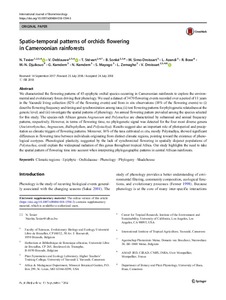| dc.contributor.author | Texier, N. |
| dc.contributor.author | Deblauwe, V. |
| dc.contributor.author | Stévart, B. |
| dc.contributor.author | Sonké, B. |
| dc.contributor.author | Simo-Droissart, M. |
| dc.contributor.author | Azandi, L. |
| dc.contributor.author | Bose, R. |
| dc.contributor.author | Djuikouo K., M.N. |
| dc.contributor.author | Kamdem, G. |
| dc.contributor.author | Kamdem, N. |
| dc.contributor.author | Mayogo, S. |
| dc.contributor.author | Zemagho, L. |
| dc.contributor.author | Droissart, V. |
| dc.date.accessioned | 2019-12-04T11:26:27Z |
| dc.date.available | 2019-12-04T11:26:27Z |
| dc.date.issued | 2018-09-13 |
| dc.identifier.citation | Texier, N., Deblauwe, V., Stévart, T., Sonké, B., Simo-Droissart, M., Azandi, L., ... & Mayogo, S. (2018). Spatio-temporal patterns of orchids flowering in Cameroonian rainforests. International Journal of Biometeorology, 1-14. |
| dc.identifier.issn | 0020-7128 |
| dc.identifier.uri | https://hdl.handle.net/20.500.12478/4607 |
| dc.description.abstract | We characterized the flowering patterns of 45 epiphytic orchid species occurring in Cameroonian rainforests to explore the environmental and evolutionary forces driving their phenology. We used a dataset of 3470 flowering events recorded over a period of 11 years in the Yaoundé living collection (82% of the flowering events) and from in situ observations (18% of the flowering events) to (i) describe flowering frequency and timing and synchronization among taxa; (ii) test flowering patterns for phylogenetic relatedness at the generic level; and (iii) investigate the spatial patterns of phenology. An annual flowering pattern prevailed among the species selected for this study. The species-rich African genera Angraecum and Polystachya are characterized by subannual and annual frequency patterns, respectively. However, in terms of flowering time, no phylogenetic signal was detected for the four most diverse genera (Ancistrorhynchus, Angraecum, Bulbophyllum, and Polystachya). Results suggest also an important role of photoperiod and precipitation as climatic triggers of flowering patterns. Moreover, 16% of the taxa cultivated ex situ, mostly Polystachya, showed significant differences in flowering time between individuals originating from distinct climatic regions, pointing toward the existence of phenological ecotypes. Phenological plasticity, suggested by the lack of synchronized flowering in spatially disjunct populations of Polystachya, could explain the widespread radiation of this genus throughout tropical Africa. Our study highlights the need to take the spatial pattern of flowering time into account when interpreting phylogeographic patterns in central African rainforests. |
| dc.format.extent | 1-14 |
| dc.language.iso | en |
| dc.subject | Epiphyte |
| dc.subject | Orchidaceae |
| dc.subject | Phenology |
| dc.subject | Phylogeny |
| dc.title | Spatio-temporal patterns of orchids flowering in Cameroonian rainforests |
| dc.type | Journal Article |
| dc.description.version | Peer Review |
| cg.contributor.affiliation | Université Libre de Bruxelles |
| cg.contributor.affiliation | International Institute of Tropical Agriculture |
| cg.contributor.affiliation | University of Yaoundé |
| cg.contributor.affiliation | Université de Montpellier |
| cg.contributor.affiliation | University of Buea |
| cg.coverage.region | Africa |
| cg.coverage.region | Central Africa |
| cg.coverage.country | Cameroon |
| cg.creator.identifier | Vincent Deblauwe: 0000-0001-9881-1052 |
| cg.researchtheme | NATURAL RESOURCE MANAGEMENT |
| cg.isijournal | ISI Journal |
| cg.authorship.types | CGIAR and developing country institute |
| cg.iitasubject | Natural Resource Management |
| cg.journal | International Journal of Biometeorology |
| cg.howpublished | Formally Published |
| cg.accessibilitystatus | Limited Access |
| local.dspaceid | 100986 |
| cg.targetaudience | Scientists |
| cg.identifier.doi | https://dx.doi.org/10.1007/s00484-018-1594-3 |

